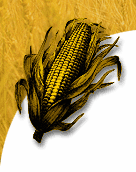

  |
|
|
Nature disavowal of article aside, transgenic corn contamination in Mexico still likely By Robert Schubert
(April 4, 2002 – CropChoice opinion) – The journal Nature was mistaken to all but retract from its Nov. 29 edition a paper in which two scientists documented their research showing transgenic corn contamination in Mexico. Contrary to what casual readers likely will infer from its headline, "Suspect evidence of transgenic contamination," critics have disputed the secondary conclusion of the study, not the primary finding: Genetically modified corn has contaminated indigenous varieties in remote areas of Mexico.
Potential agronomic and economic implications involved with this issue bear on the interests of U.S. corn farmers.
University of California at Berkeley researchers David Quist and Ignacio Chapela discovered in native corn from southern Mexico three separate constructs – a virus and two bacteria, including bacillus thuringiensis (Bt) – that genetic engineers commonly use to transgenically modify plants.
Before publicizing their work, Quist and Chapela notified Mexican authorities about the contamination. Government officials responded by conducting their own studies, which confirmed the original findings; they reported the results in October.
What’s more, the Mexican government is now running three additional independent studies. So far, Ignacio Chapela said today at a news conference, the preliminary findings support the original conclusion that transgenic DNA has contaminated local landraces. (See the original paper "Transgenic DNA introgressed into traditional maize landraces in Qaxaca, Mexico" http://www.checkbiotech.org/root/index.cfm?fuseaction=news&doc_id=2274&start=1&control=154&page_start=1&page_nr=101&pg=1#.)
What the letters that Nature published today (along with a reply and more evidence from the California researchers) are assailing is the second conclusion.
Beyond identifying the contamination, Quist and Chapela wanted to establish a context for the presence of the transgenes. In other words, did the genes from the Bt corn appear in the genetic structure of the native varieties because of hybridization (most likely from cross-pollination)? They concluded, using inverse PCR testing, that the answer was yes.
They discovered that genes from the transgenic corn integrated into multiple points along the native genome. In other words, there were many occasions for contamination.
Potentially more disturbing than contamination from pieces of the genetically modified corn DNA are the effects it could have down the line. The transgenes could reshuffle in the genetic material (heritable) of the native corn as they get passed to successive generations. This could affect the plants in various ways. For example, it might change the structure of the proteins, which in turn could affect how a person’s digestive system reacts to them.
Quist conceded that "there are legitimate contentions about two of the eight sequences we reported on in the original paper."
Overall, though, "We are interpreting these results through distinctly different lenses," he said. "Our critics are using the lens of plant genomics and genetic engineering to determine which of these patterns are significant and relevant. They are concerned with intact constructs producing proteins of interest. They’re not concerned with gene fragments and the effects those might have.
"On the other hand, we’re looking at it through the lens of ecology and population biology in which the patterns we see in samples out of nature and their importance need to be considered."
At least two reasons come to mind why corn growers should be concerned about all of this.
In the long run, breeders need a pure source of corn from which to make new hybrids. That’d be difficult if the native Mexican lines were further contaminated. In the short or medium term, Mexico – the third largest market for our corn – could move to protect its indigenous varieties by shutting the doors to U.S. corn imports. | |